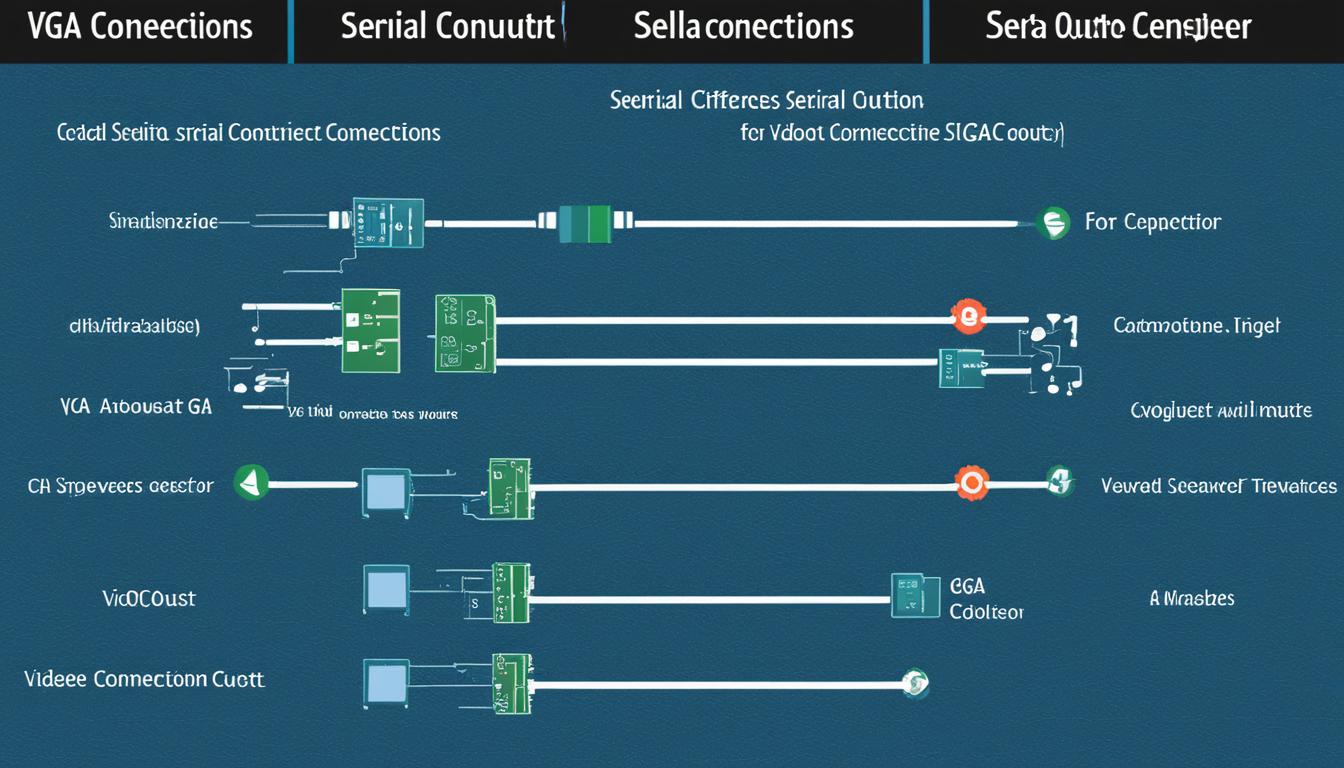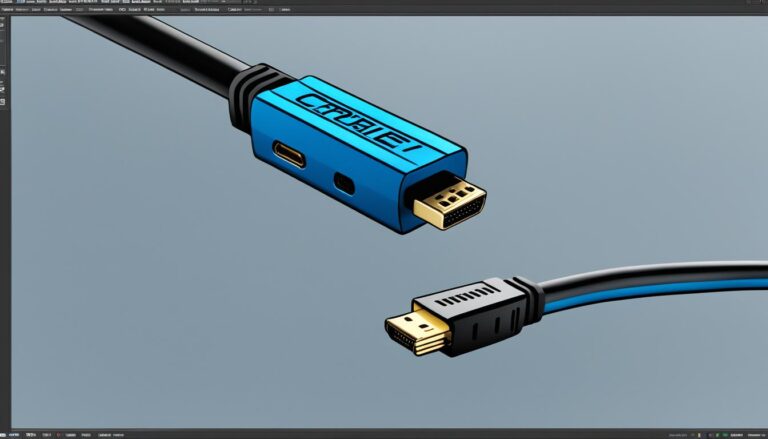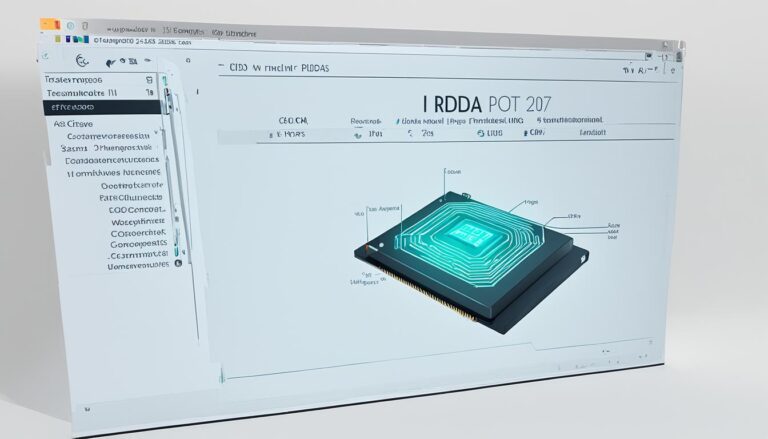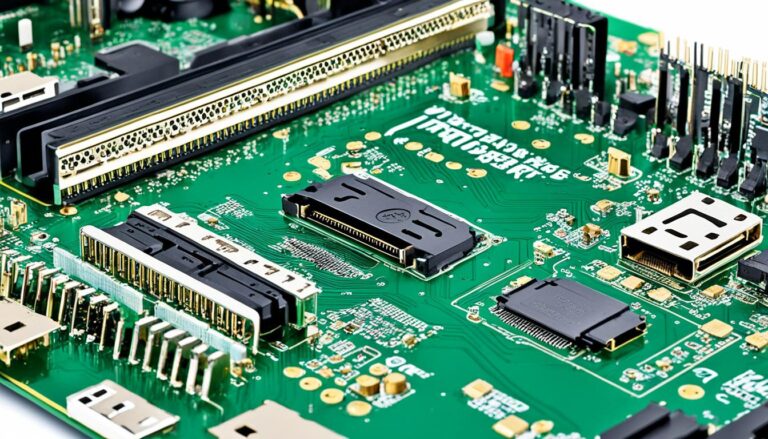In the world of video output, VGA and Serial connections stand out. This article looks into how these two differ. We consider their impact on video quality and performance. Whether you love tech or need video solutions, knowing about VGA and Serial is key.
During this comparison, remember the critical terms: VGA vs Serial and Video Output Options. We will weave these keywords into our discussion. This makes the article more visible and relevant.
Understanding VGA Connections
VGA, or Video Graphics Array, is a well-known analog video connection. It has been around for many years. It has a 15-pin connector. Video resolutions supported include 640×480 and 800×600. VGA connections are seen on computer monitors, laptops, and older TVs. They give good video output but are limited to analog signals. They may not handle higher resolutions or features of new digital connections.
VGA connections are chosen for their wide availability and compatibility. They are used in offices, homes, and schools. The 15-pin VGA connector, often blue, is a standard for connecting screens and devices.
VGA connections can handle different video resolutions. The most common are 640×480 and 800×600. These are fine for everyday computer use. But, VGA might not give the best video quality for higher resolutions or features of new digital connections like HDMI or DisplayPort.
Still, VGA connections are a reliable choice for many. They work with lots of devices, including old computers, projectors, and monitors. They are also easy to set up. You don’t need much extra hardware or adapters.
It’s important to note VGA connections send analog signals. This can cause a drop in video quality compared to digital connections. The analog nature of VGA means video signals can weaken with distance or interference.
When picking VGA connections for video output, think about what you need. If you mainly use standard resolutions and don’t need new digital features, VGA can be good enough.
Advantages of VGA Connections:
- Widely available and compatible with many devices
- Support for common video resolutions, such as 640×480 and 800×600
- Relatively easy to set up with minimal additional hardware
Disadvantages of VGA Connections:
- Limited support for higher resolutions and advanced features
- Potential loss in video quality due to analog signal transmission
- Susceptibility to signal interference or degradation over longer cable distances
Exploring Serial Connections
Serial connections, known too as RS-232 or COM ports, are key for device communication. They weren’t meant for video at first. Yet, they can send video in certain situations. But, there are limits to their video performance.
When compared with VGA, Serial connections are slower. They might not handle high-res or fast displays well. This could lower video quality. Sometimes, you might need extra gear or adaptors for the right format.
Let’s look at Serial connections’ video limits:
- They have slower speeds, which can be tricky for high-quality video.
- They might not support big resolutions or fast display rates.
- Extra gear or adaptors might be needed for the right video format.
We should think about these limits for video needs with Serial ports. Where high-quality video is a must, other options like VGA might be better.
Key limitations of Serial connections for video output performance:
Compared to VGA, Serial connections are slower.
They may not work with high-res or fast displays.
Extra
gear or adaptors could be needed for the correct format.
| Connection Type | Transmission Speed | Supported Resolutions | Compatibility |
|---|---|---|---|
| VGA | Fast | Many resolutions supported, including HD | Most modern devices support it, rarely needs extra gear |
| Serial Connections | Slower | Limited high-res support | Often requires more gear or adaptors |
This table shows how VGA and Serial connections differ in speed, resolution support, and compatibility.
Comparing Video Output Quality
When we talk about video quality between VGA and Serial connections, we must think of display type and wanted resolution. VGA can give nice video quality for standard displays. But, it might not work for high-definition screens. Serial connections may not offer great resolution or refresh rates. This can lead to poorer video quality than VGA or digital options.
VGA connections are often the better choice for great video quality.
Let’s look at an example to see the differences in video quality with VGA and Serial:
Example Scenario:
A user wants to link their computer to a high-definition TV for movies and games. They are choosing between VGA and Serial. To get the best video quality, VGA is suggested. VGA offers good quality for standard displays, even high-definition ones. Serial might give lower quality because of its resolution and refresh rate limits.
Picking the right video output connection helps users get the video quality they want for their devices and displays.
Performance Considerations
VGA connections excel in video output performance over Serial connections. They support higher resolutions and faster refresh rates. This results in smoother video. They work well with many types of devices and displays.
However, Serial connections might not do as well with high-resolution or fast displays. They were not designed for top-notch video performance like VGA connections. Sometimes, they might offer a less satisfying viewing experience.
If great video quality is important to you, choose VGA connections. They are the best for high-resolution and fast displays.
Benefits of VGA Connections for Video Output Performance:
- Support for higher resolutions
- Faster refresh rates
- Smoother video playback
- Compatibility with a wide range of devices and displays
Making the right choice in video output connections is key. It means you’ll get the visual experience you’re hoping for.
| Aspect | VGA Connections | Serial Connections |
|---|---|---|
| Video Output Quality | High | Lower than VGA |
| Resolution Support | Wide range of resolutions | May have limitations |
| Refresh Rate | Fast | May be slower |
| Versatility | Compatible with various devices | Limited compatibility |
Table: A comparison of video output performance between VGA and Serial connections.
The table highlights how VGA connections lead in video quality, resolution, speed, and versatility. VGA connections are a solid choice for top-level video performance.
Compatibility and Availability
VGA connections work with many devices like computers and monitors. They fit most VGA-enabled displays without needing extra hardware. Serial connections, however, might not work with newer displays. They’re mainly on older devices that use serial communication. If you need reliable video output, VGA is often the better option.
To show the differences between VGA and Serial connections, here’s a table:
| VGA Connections | Serial Connections |
|---|---|
| Widely supported and available on various devices | Primarily found on older equipment or specific industrial applications |
| Compatible with most VGA-enabled displays | May have limited compatibility with modern displays and devices |
| Minimal additional hardware or adapters required | May require additional hardware or adapters to convert the video signal |
The table highlights how VGA offers better compatibility and availability. You’ll find VGA ports on many devices easily. They also connect to most VGA displays without extra bits. On the flip side, Serial ports are more niche. They suit certain industrial needs and old devices better.
Future Considerations
As technology moves forward quickly, it’s key to think about what’s next for video connections like VGA and Serial.
VGA connections were popular but are now fading away. Newer digital options like HDMI, DisplayPort, and DVI are taking over. These offer clearer videos, better resolution, and more features.
Serial connections aren’t as useful for today’s video needs. They’re mainly for certain industries or old systems. Serial might not fit the future’s video technology.
For future video needs, digital connections are the way to go. They give you better quality and work with new technology.
Choosing HDMI, DisplayPort, or DVI means your video setup is ready for the future. You’ll be set for new tech, higher quality, and more features.
“The future of video output lies in digital connections, offering superior quality and compatibility with emerging technologies.”
By going digital, you’re prepared for the latest devices and screens. Choosing HDMI, DisplayPort, or DVI is the smart move for the future.
| Advantages | VGA | Serial |
|---|---|---|
| Video Output Quality | Fair | Variable |
| Resolution Support | Standard | Variable |
| Compatibility | Widespread | Limited |
Note: The benefits mentioned compare to newer digital connections like HDMI, DisplayPort, and DVI.
Conclusion
When looking at video output options, it’s important to think about VGA and Serial connections. VGA offers great video quality and is easy to use with many devices. It works well for most needs unless you need very high-quality video.
Serial connections are different. They are better for certain tasks but not for high-quality video. They might be slow and not support high resolutions. You often find them in old or special equipment that needs serial communication.
Choosing between VGA and Serial means thinking about what you need. If you want good video quality and easy use with many devices, go for VGA. But, if you’re working with special industrial systems or old equipment, Serial might be better.
In the end, it all comes down to your own needs. Think about the video quality, how it will work with your devices, and what you’ll need in the future. This will help you choose the right connection and meet your goals.
FAQ
What is VGA?
VGA stands for Video Graphics Array. It’s an analog video connection that’s been around for a long time. It relies on a 15-pin connector. VGA supports different video resolutions.
Where can VGA connections be found?
You can find VGA connections on computer monitors, laptops, and some older TVs.
What are the limitations of VGA connections?
VGA is limited to analog signals. It might not support the higher resolutions or new features of digital connections.
What are Serial connections?
Serial connections, known also as RS-232 or COM ports, help devices communicate. In some cases, they’re used for sending video signals.
Are Serial connections slower than VGA?
Yes, Serial connections are generally slower. VGA and other digital connections are faster.
Do Serial connections support high-resolution displays?
Serial connections might struggle with high resolution. They usually don’t support high-refresh rate or high-resolution displays.
Do VGA connections have better video output quality?
VGA can offer good video quality for standard resolutions. However, it might not manage high-definition or ultra-high-definition displays well.
Which connection offers better video output performance?
VGA usually gives better performance than Serial connections. It supports higher resolutions and smoother video.
Which connection is more versatile?
VGA is more versatile. It works with many devices and displays. Serial connections might not work with modern equipment.
Are VGA connections being phased out?
Yes, VGA connections are slowly being replaced by digital connections. Think HDMI, DisplayPort, and DVI.
Are Serial connections still used in modern video output scenarios?
Serial connections are rarely used in modern setups. They’re mainly for specific industrial or older systems.












